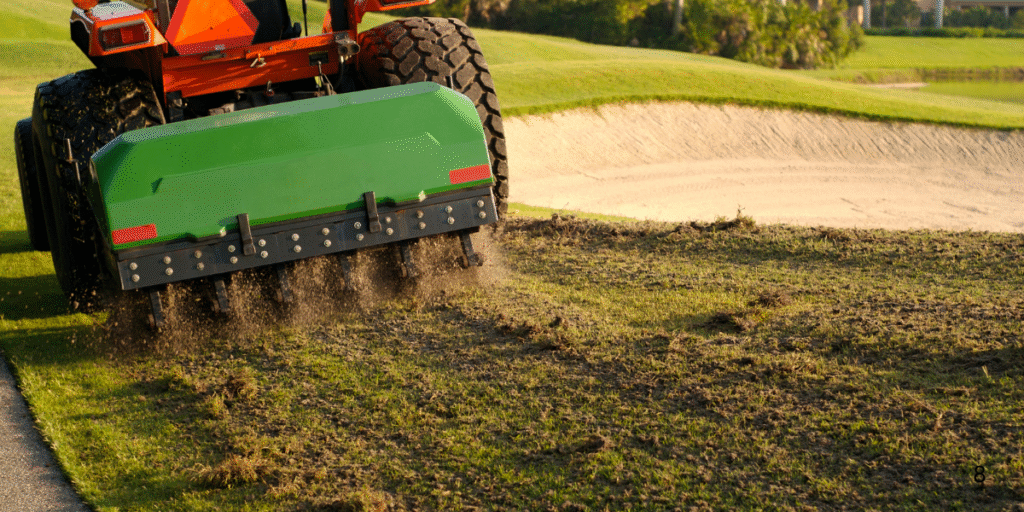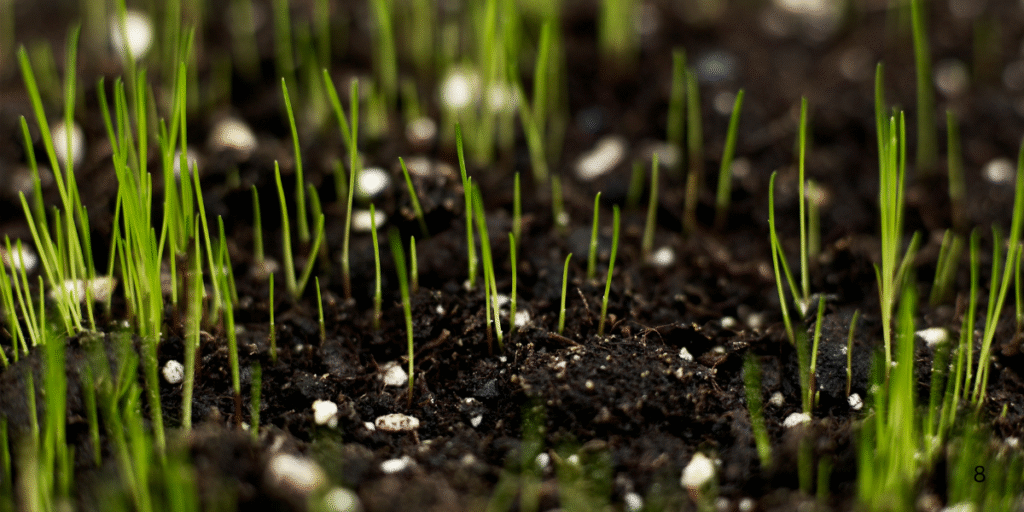As the summer heat fades and cooler temperatures settle over Canton, MA, many lawns begin to show signs of stress — thinning grass, compacted soil, and dull color. Fall provides a critical recovery window. This is when lawn aeration and overseeding become essential steps for restoring strength, thickness, and long-term resilience.
At Molloy Lawn & Landscape, we’ve seen how dramatically these two treatments can transform Canton lawns. Aeration relieves soil compaction while overseeding fills in bare areas, helping lawns recover from summer damage and prepare for winter dormancy. Together, they create the foundation for a lush, vibrant lawn next spring.
What Is Lawn Aeration and Why Does It Matter

Lawn aeration is the process of creating small holes in the soil to loosen compaction and improve the movement of water, nutrients, and oxygen to the roots. Over time, everyday activities like mowing, foot traffic, and even rainfall can compact the soil, making it harder for roots to grow. When soil becomes dense, water pools on the surface and grass roots stay shallow, leaving the lawn more vulnerable to drought and heat stress.
Canton’s mix of clay and loam soils makes local lawns particularly prone to compaction, especially after humid summers. Aeration opens the soil structure, allowing roots to spread deeper and build strength before winter. The most effective approach for Canton’s conditions is core aeration, which removes small plugs of soil from the lawn surface. This technique provides lasting improvement in root development and overall soil health.
Why Overseeding Is Just as Important

Overseeding means spreading new grass seed over an existing lawn to encourage fresh growth and improve density. It’s the perfect partner to aeration because it allows new seeds to settle into the open soil plugs created during the process. That direct soil contact gives seeds an ideal environment to germinate and establish themselves.
Fall offers the best conditions for overseeding in Canton. The combination of warm soil, cool air, and consistent moisture creates the perfect setting for new seedlings to grow without being outcompeted by weeds. Overseeding in fall also helps fill in bare or thin spots left behind by summer heat, insect activity, or heavy use, ensuring your lawn goes into winter stronger and thicker.
The Science Behind Combining Aeration and Overseeding
Aeration and overseeding are most powerful when performed together. Aeration opens up the soil and relieves compaction, while overseeding introduces new grass varieties into the lawn. This improves root diversity, disease resistance, and overall durability.
When seeds fall into aeration holes, they’re naturally protected from wind and birds while still getting direct access to soil nutrients and moisture. As a result, germination rates increase significantly compared to overseeding alone. Within a few weeks, new blades begin to emerge, filling gaps and restoring the lawn’s uniform color and texture.
In Canton’s variable climate — where hot summers and icy winters create constant stress — this combination is one of the most reliable ways to maintain a healthy, dense lawn.
When to Aerate and Overseed in Canton, MA
The best time for lawn aeration and overseeding in Canton, MA is from early September through mid-October. During this period, the soil remains warm enough for seed germination, while cooler air temperatures reduce stress on existing grass. There’s also typically enough rainfall to keep the soil moist, encouraging strong root establishment before the ground freezes.
Timing is crucial. Aerating too early in summer can expose roots to heat stress, while waiting too long can prevent new seedlings from maturing before winter. Homeowners should aim to complete these treatments at least four to six weeks before the first expected frost, which usually arrives in late October in the Canton area.
The ideal conditions are mild daytime temperatures between 60°F and 75°F and soil that is slightly moist but not soggy. Aerating and seeding under these conditions give your lawn the best possible chance to establish before winter dormancy sets in.
Signs Your Lawn Needs Aeration and Overseeding
Many homeowners don’t realize their lawn needs aeration until visible symptoms appear. Common warning signs include compacted soil that feels hard underfoot, thin grass coverage, or water pooling on the surface after rain. You might also notice areas where the grass has stopped growing entirely despite regular watering.
Another telltale sign is difficulty pushing a screwdriver or stake into the ground, which indicates the soil has compacted to the point where roots can’t penetrate deeply. Lawns that experience frequent foot traffic, such as backyards with pets or children, are often the first to show these issues.
In Canton, lawns also experience stress after long periods of rain or during summer heat. When these conditions pass, aeration and overseeding help restore oxygen flow and reinvigorate the root system before the next seasonal cycle.
How Canton’s Climate Affects Fall Lawn Care
Canton, MA, has a humid continental climate, meaning it experiences hot summers and cold winters with regular rainfall throughout the year. The warm, humid months of July and August tend to compact soil and weaken turf roots, while the cold winter months create dormancy stress.
Fall, however, offers an ideal balance — cooler air, moderate rainfall, and fewer weeds competing for nutrients. This makes it the most effective time for fall lawn care in Canton, MA. Aeration and overseeding during this window allow lawns to rebuild their strength, store nutrients, and prepare for the temperature drops ahead.
Step-by-Step Guide to Aeration and Overseeding
Proper technique makes all the difference when aerating and overseeding your lawn. Begin by mowing the grass shorter than usual, around two to two-and-a-half inches, and watering deeply a day or two beforehand. This softens the soil, allowing the aerator’s tines to penetrate easily.
During aeration, mechanical core aerators should be used to remove plugs about two to three inches deep. Overlap passes slightly to ensure even coverage across the lawn. Once aeration is complete, immediately spread high-quality cool-season grass seed — typically a blend of Kentucky bluegrass, ryegrass, and fescue varieties suited for the Canton area.
After seeding, apply a starter fertilizer that’s high in phosphorus to encourage strong root growth. Water regularly, keeping the top inch of soil moist for the first two weeks. Avoid mowing until the new grass reaches three inches in height, and limit heavy foot traffic to allow seedlings to establish fully.
Avoiding Common Mistakes
A few simple missteps can undermine an otherwise well-planned aeration and overseeding project. Aerating when the soil is dry or frozen, for example, prevents the tines from reaching the correct depth. Skipping watering after overseeding is another common error; consistent moisture is critical for successful germination.
Some homeowners also make the mistake of over-seeding, assuming more seed equals better results. In reality, overcrowding can reduce airflow and promote fungal growth. Applying too much fertilizer can have a similar effect, stimulating excessive top growth before roots have time to develop. The key is balance: even coverage, proper watering, and patience during establishment.
The Visible Benefits of Aeration and Overseeding
Within a few weeks, homeowners who invest in aeration and overseeding begin to see clear results. The lawn appears thicker and greener, with fewer bare spots and improved color uniformity. Water drains more effectively, roots grow deeper, and the turf develops a more resilient structure that can better handle winter cold and spring growth.
Long-term benefits include reduced thatch buildup, improved drought resistance, and fewer pest and disease issues. Most importantly, the lawn becomes easier to maintain — requiring less water and fertilizer to stay healthy year-round.
Frequently Asked Questions
How often should a Canton lawn be aerated?
Once a year is ideal for most lawns; however, lawns with heavy foot traffic or clay-heavy soil may benefit from aeration twice a year — once in the spring and once in the fall.
Can I aerate and overseed in the spring instead?
Spring aeration can help, but fall remains the superior time. The cooler temperatures and declining weed competition give new grass the best environment to thrive.
Should I remove soil plugs after aeration?
No, it’s best to leave them in place. They’ll naturally decompose over time, enriching the soil with organic matter.
Will overseeding fix dead patches completely?
Yes, provided the soil is properly prepared and watered. Aeration ensures new seeds have access to oxygen, nutrients, and the space they need to grow strong.
How Molloy Lawn & Landscape Can Help
At Molloy Lawn & Landscape, we’ve been helping homeowners in Canton and surrounding areas achieve healthy, resilient lawns since 1963. Our lawn aeration and overseeding services in Canton, MA are tailored to the region’s unique soil conditions and weather patterns.
We use professional-grade core aeration equipment to relieve compaction and improve root structure. Our overseeding process introduces high-quality grass varieties that thrive in Canton’s climate, helping lawns recover from summer damage and build lasting density before winter. Each service is timed and performed with precision to maximize germination and ensure even, consistent coverage.
With decades of experience and a reputation built on reliable results, Molloy Lawn & Landscape continues to help Canton homeowners enjoy greener, healthier lawns season after season.


https://shorturl.fm/cacFu
https://shorturl.fm/HmCea
https://shorturl.fm/r4T33
https://shorturl.fm/iYqtw
https://shorturl.fm/uCbUT
https://shorturl.fm/KzFDo
https://shorturl.fm/T5d0J
https://shorturl.fm/lJ9Ym
https://shorturl.fm/MrX0t
https://shorturl.fm/kM7Fa
https://shorturl.fm/6FKmI
https://shorturl.fm/JijuT
https://shorturl.fm/yWKx4
https://shorturl.fm/hqeRt
https://shorturl.fm/OXGh8
https://shorturl.fm/o0v7C
https://shorturl.fm/s7POB
https://shorturl.fm/bL3Br
https://shorturl.fm/ijKZ6
https://shorturl.fm/4ZlWf
https://shorturl.fm/daqqs
https://shorturl.fm/k0bq8
https://shorturl.fm/JDY9v
https://shorturl.fm/5RjBk
https://shorturl.fm/Elh78
https://shorturl.fm/tUdil
https://shorturl.fm/jB9G4
https://shorturl.fm/QAg5S
https://shorturl.fm/haVt3
https://shorturl.fm/P58w0
https://shorturl.fm/5mSA1
https://shorturl.fm/b4vUe
https://shorturl.fm/VanTd
https://shorturl.fm/nYSDh
https://shorturl.fm/btWlx
https://shorturl.fm/OlLdC
https://shorturl.fm/jDuiL
https://shorturl.fm/DWcWX
https://shorturl.fm/BLMyq
https://shorturl.fm/81bMn
https://shorturl.fm/x73c5
https://shorturl.fm/3o3LQ
https://shorturl.fm/WSrvQ
https://shorturl.fm/sf1Z4
https://shorturl.fm/V1puX
https://shorturl.fm/rm7KY
https://shorturl.fm/ohBYX
https://shorturl.fm/h6v0K
https://shorturl.fm/8aGdS
https://shorturl.fm/wxK2W
https://shorturl.fm/7qb2p
https://shorturl.fm/0GIHZ
https://shorturl.fm/UoWcr
https://shorturl.fm/wKb9g
https://shorturl.fm/23fYa
https://shorturl.fm/v82aX
https://shorturl.fm/N0BzB
https://shorturl.fm/TFs4Q
https://shorturl.fm/4wrQv
https://shorturl.fm/dyq5m
https://shorturl.fm/DngOW
https://shorturl.fm/RNXw3
https://shorturl.fm/IkXR6
https://shorturl.fm/5Ovds